
Introduction
St. Peter am Perlach or Perlach-Church is a romanesque Catholic church in the center of Augsburg (Bavaria), Germany. The tower of the church, the Perlachturm, is together with the Augsburg Town Hall the landmark of Augsburg.
The image and Marian devotion in St. Peter Mary Untier of Knots is also known in Latin America miraculous image of Mary Knots. A copy of the painting is in San José del Talar a church in Buenos Aires (Argentina).
History of St. Peter am Perlach, Augsburg
“St. Peter am Perlach” is one of the oldest churches in the city of Augsburg, which dates back at least to the 11th century. The three naves of a Romanesque hall church, which are still clearly recognizable today, are evidence of its great age. Particularly noteworthy is a small terracotta figure that shows Jesus Christ, who turns to people in blessing. This representation was created around “Pantokrator” around 1200 and can be found in the entrance area.
St. Peter is a gem in many respects and is located in the heart of the city of Augsburg. The entrance to the church is a little hidden at the “Fischmarkt” opposite the magnificent town hall on the south side of the mighty Perlachturm, which is a symbol of Augsburg and at the same time the tower of St. Peter.
The manageable and closed space of the church offers the opportunity to find an oasis of peace and quiet in the midst of the bustle of our city. Many people from Augsburg and the surrounding area take advantage of this opportunity every day. But there are also visitors from all parts of Germany and from almost every country on the continent. An important reason for this is a picture of Mary that was created around 1700 and shows a unique motif: Mary as the “Madonna of the Knot” or “the knot-looser”.
Pope Francis has been a great admirer of our “Madonna of the Knot” since 1986. He was so impressed by this depiction of Mary at the time that he promoted the worship of the “Virgin of the Knot” in Argentina, from where it spread throughout South America. Many from these countries deliberately come to Augsburg on their European tour to see the original and to pray in front of it.
Architecture

Architectural Style: Romanesque Architecture
Little is known about the exact circumstances of the founding of a fraternity at St. Peter’s. In the tradition, a mass in 1780 is mentioned. With the dissolution of the monastery of St. Peter, the church was initially to be demolished, which was prevented by the resistance of individual members of the Mass League. From this group of citizens of the city of Augsburg, some have agreed to take care of the upkeep of the church.
A royal rescript dated March 20, 1811 reopened the church for daily worship. In order to ensure the preservation of St. Peter, an administration for St. Peter’s Church was set up on July 14, 1852, from which a board of directors consisting of six people was elected in 1854. The administration took over the care and administration of the church, took care of the holding of the service, the appointment of a permanent priest and a sacristan, the procurement of paraments,
In 1913 the administration was registered under the name “Bürgerverein bei St. Peter am Perlach eV”. In contracts between the Bavarian state and the citizens’ association in 1913 and 1919, the mutual rights and obligations at St. Peter’s Church were regulated.
Pilgrimage to "Maria Knot Solver"
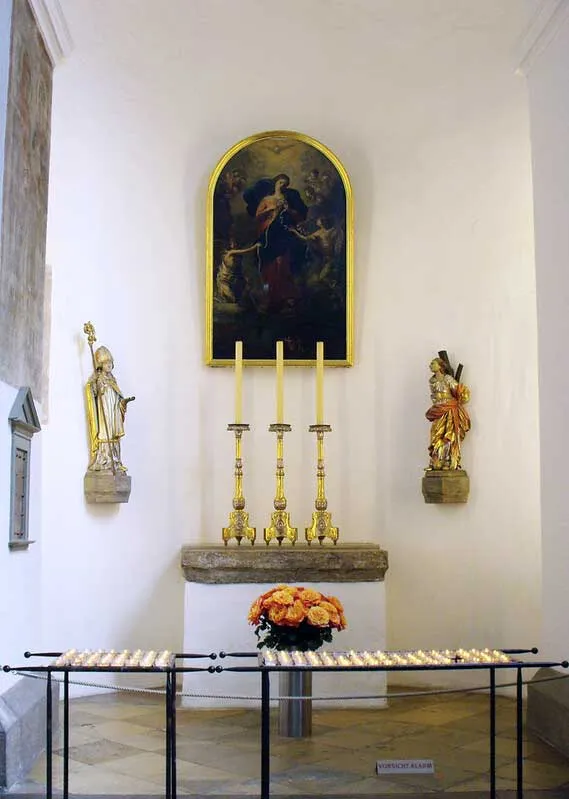
In 1700 the Augsburg patrician Hieronymus Ambrosius Langenmantel (canon of St. Peter 1666-1709) is said to have donated the altar Beatae Mariae Virginis with the current pilgrimage image of MARIA KNOTENLÖSERIN.
The depiction in the southern apse is unique. It shows the Mother of God untying the tangled knots in a long ribbon and at the same time crushing the snake’s head with one foot. “The knot of Eve’s disobedience was untied by the obedience of Mary. What the Virgin Eve bound by her unbelief, Mary loosed by faith. St. Irenaeus of Lyons already had a similar thought.
Mary presents herself as the new Eve. The trampling of the serpent indicates that Mary is exempt from all taint of original sin from the beginning and by special grace.
As described in the Book of Revelation, Mary stands before us clothed with the sun, the moon under her feet and a crown of 12 stars on her head. The dove is an allusion to Mary as the bride of the Holy Spirit. The small scene at the bottom edge of the picture, where an angel leads a hiker with his dog to a church (Tobit and the Guardian Angel), could have been a special wish of the client.
Mary, Untier of Knots (Mary, Undoer of Knots)
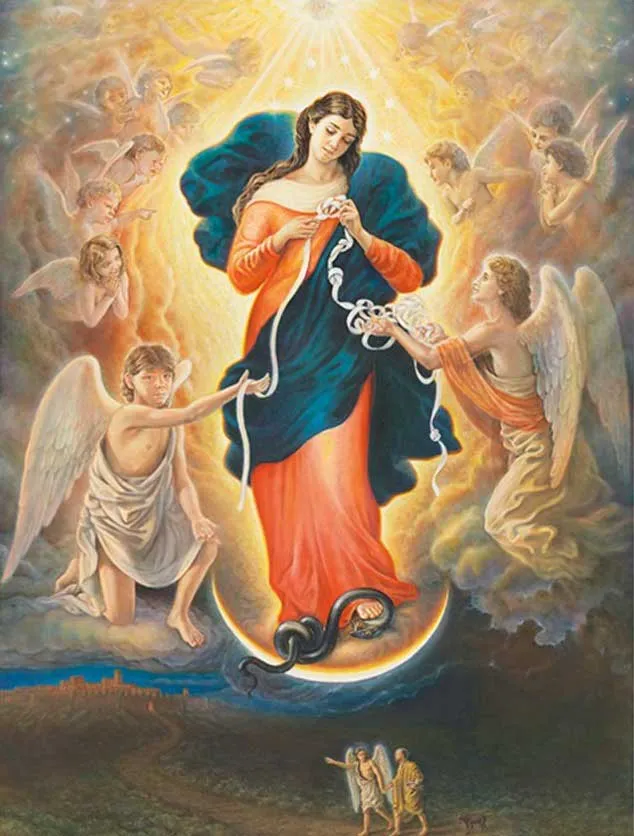
Mary, Untier of Knots or Mary, Undoer of Knots is the name of both a Marian devotion and a Baroque painting (German: Wallfahrtsbild or Gnadenbild) which represents that devotion also known as Our Lady of Untier of Knots or Our Lady of Undoer of Knots.
The painting by Johann Georg Melchior Schmidtner, of around 1700, is in the Catholic pilgrimage church of St. Peter am Perlach, otherwise known as the Perlach church, in Augsburg, Bavaria, Germany. Devotion to the image had been limited to certain countries in Latin America (e.g., Argentina, Brazil) but became known worldwide following the election of Pope Francis.
Painting of Mary, Untier of Knots
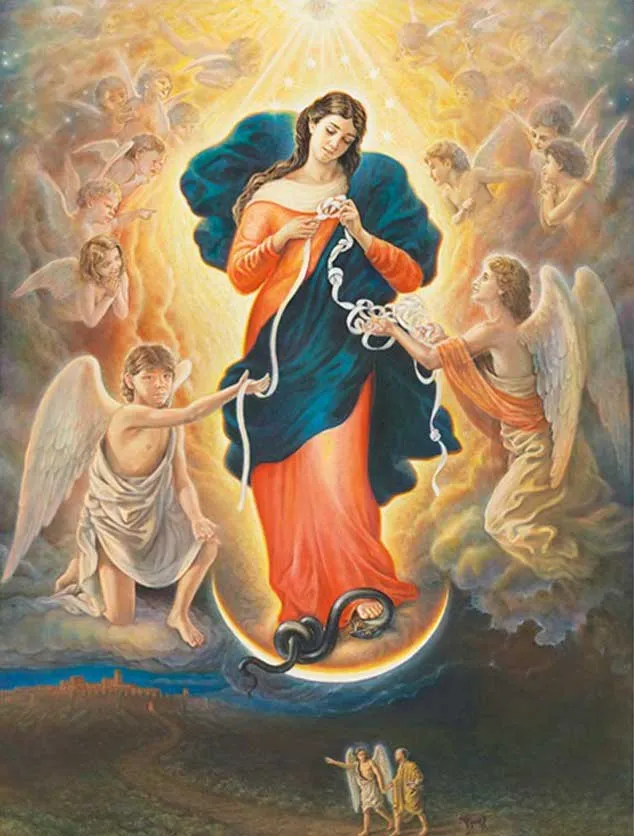
The painting, executed in the Baroque style by Johann Georg Melchior Schmidtner (1625-1707), shows the Blessed Virgin Mary standing on the crescent moon (the usual way of depicting Mary under her title of the Immaculate Conception), surrounded by angels and with the Holy Spirit in the form of a dove hovering above her circle of stars as she unties knots from a long ribbon and at the same time rests her foot on the head of a “knotted” snake.
The concept of Mary untying knots is derived from a work by St. Irenaeus of Lyons, Adversus haereses (Against Heresies). In Book III, Chapter 22, he presents a parallel between Eve and Mary, describing how “the knot of Eve’s disobedience was loosed by the obedience of Mary. For what the virgin Eve had bound fast through unbelief, this did the virgin Mary set free through faith.”
The two small figures have also been interpreted as a representation of Wolfgang Langenmantel, the grandfather of the benefactor, guided in his distress by a guardian angel to Father Jakob Rem in Ingolstadt.
History of Mary, Untier of Knots
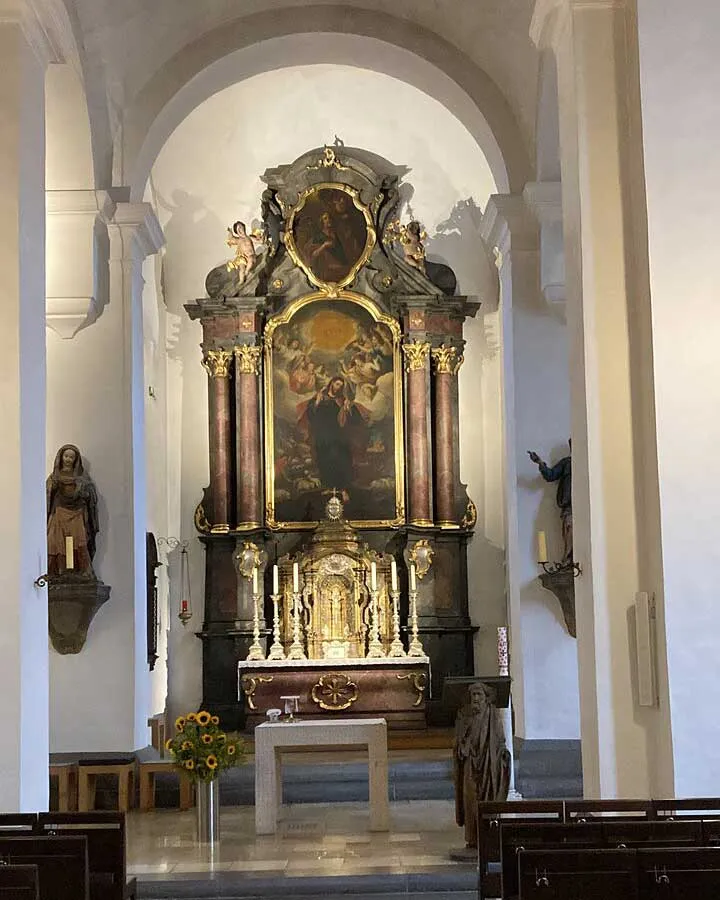
The painting was donated around 1700 by Hieronymus Ambrosius Langenmantel, a canon of the Monastery of Saint Peter in Augsburg. The donation is said to be connected with an event in his family.
His grandfather Wolfgang Langenmantel (1586-1637) was on the verge of the separation from his wife Sophia Rentz (1590-1649) and therefore sought help from Jakob Rem, the Jesuit priest in Ingolstadt. Father Rem prayed to the Blessed Virgin Mary and said: “In diesem religiösen Akt erhebe ich das Band der Ehe, löse alle Knoten und glätte es [In this religious act, I raise the bonds of matrimony, to untie all knots and smoothen them]”.
Immediately peace was restored between the husband and wife, and the separation did not happen. In the memory of this event, their grandson commissioned the painting of the “Untier of Knots”
Knots in the Lives of Mary and in Joseph
How many were the knots that Mary experienced? With the angelic message delivered, Mary’s life at Nazareth was thrown into turmoil, as was Joseph’s from his dreams. They were called upon to participate in the drama of salvation. Given their mission to raise Jesus and prepare him for his adult life, the divine plan would not spare them. The grueling ninety-mile trek by donkey to register in the Bethlehem census was long and cold.
After the birth of Jesus, an angel appeared to Joseph in a dream to escape King Herod’s pursuit of destroying his rival. So, like fugitives, they fled to Egypt in the middle of the night. After a time, again in a dream, the angel ordered Joseph to return home. Why would a man like Joseph obey dreams with such steady discernment? Why indeed? Herod had died. The coast was clear. Then came predictions by Simeon and Anna about the Child’s future. The loss of the Child in the temple followed. For Mary and Joseph, it was one stressful event after the other a series of knots, intimations of the Lord’s passion shared by his parents.
It’s at the wedding at Cana that we see Mary untying a knot for others, at least in its initial stage. On a day of rejoicing, of wedding bliss, suddenly an embarrassing moment the stone jars of wine are running on empty. What will the guests say? Mary grasps the urgency before the others. Are you there to see as well? Jesus sees but plans to stay out of this embarrassing moment. The bride and groom are his mother’s friends, not his. She states the problem but skirts the obvious question, “will you?” His ready response: “Not now. It’s not my time.” She signals past him toward the attendants. “Do whatever he tells you;” she takes charge. As the jargon goes, you have to love her cool.
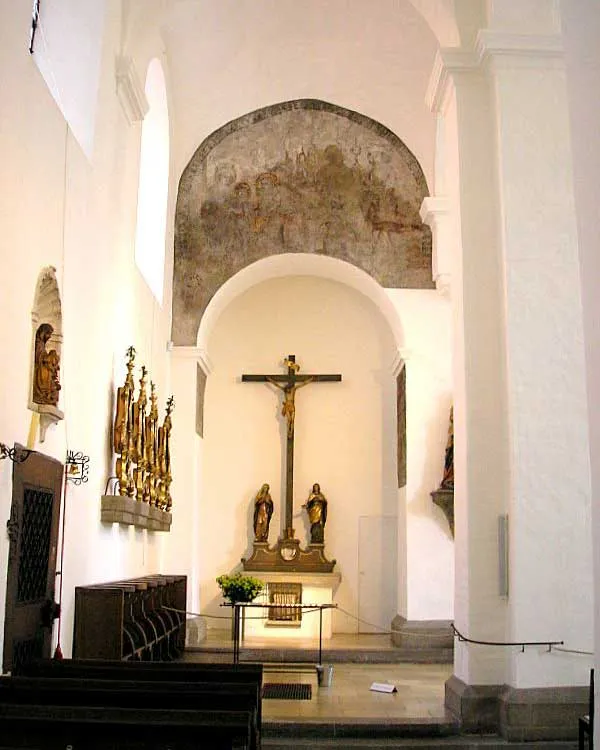
The Story Behind Our Lady, the One Who Unties Knots
The original narrative of Our Lady under this title begins in 1612 in Augsburg, Bavaria in Germany. Wolfgang Langenmantel and Sophia Rentz, husband and wife, belonged to the nobility and were on the verge of a divorce. Over a period of twenty-eight days, Wolfgang sought help from Jakob Rem, a Jesuit priest who prayed with him to Our Lady to untie the knots of their marital problems.
They prayed that she untie the marriage ribbon that had bound them together at their wedding ceremony. The divorce did not take place, and together the couple lived a peaceful married life. Years later, to commemorate this turn of events, their grandson, Fr. Hieronymus Langenmantel of St. Peter’s Monastery in Augsburg, commissioned the painting, “Untier of Knots.”
The earliest reference to this depiction of Our Lady is found in the second-century document, Adversus haereses, “Against Heresies,” written by St. Irenaeus of Lyons. In Book III, Chapter 22, he draws a parallel between Eve and Mary. “The knot of Eve’s disobedience,” he writes, “was loosed by the obedience of Mary”. In its basic theological meaning, the image symbolizes Mary untying the knot of the first sin and first act of disobedience in the Garden. Here she is actively engaged in the life struggles of men and women.
The painting, oil on poplar, was executed in 1700 by Johann Georg Schmidtner and is cast in the typical Baroque style with its dramatic flair and didactic reference. Flanked by two angels, she is untying knots from a long marriage ribbon which, in the seventeenth century, represented the marital union. It has also come to symbolize the knots that are part of any marriage or knots that become part of any walk of life. At the same time, she presses her foot to crush the head of a coiled (or knotted) serpent. The painting is located in St. Peter’s Church in Augsburg.
Pope Francis and Our Lady, Undoer of Knots
Our Lady’s ingenuity and her practical streak are captured in the title dear to the heart of Pope Francis. While studying in Germany in the 1980s, Jorge Bergoglio was inspired by a Bavarian painting entitled, “Holy Mother, Our Lady, Untier of Knots.” When he returned to Argentina with a copy of that image on a postcard, had an icon struck with this same title.
The world’s attention was drawn to the icon when Vatican Radio revealed that Pope Francis had championed the devotion decades before in Argentina. Today, devotion to Our Lady under this title is growing by leaps and bounds. It can touch those beset by sudden illness, sudden financial trouble, sudden “anything.” Devotion to Our Lady under this title is especially popular among married people, given her active role at the wedding at Cana.
There are countless visuals depicting the wedding at Cana but none more telling than that of Giotto, the fourteenth-century Florentine painter.
The fresco is the eighth of twenty-four in the life of Christ painted on the walls of the Scrovegni Chapel in Padua, Italy. A lovely panoply of originals inviting prayer, prayer according to the image before one’s eyes. This unusual fresco shows Mary with her hand raised in blessing yes as her Son performs the miracle she has initiated. On September 28th, under this title, Our Lady stands with each of us as our greatest advocate in dealing with the various knots in our lives, small, medium, large, inscrutable or intractable. There is no knot that cannot be loosed with Our Lady’s intercession.
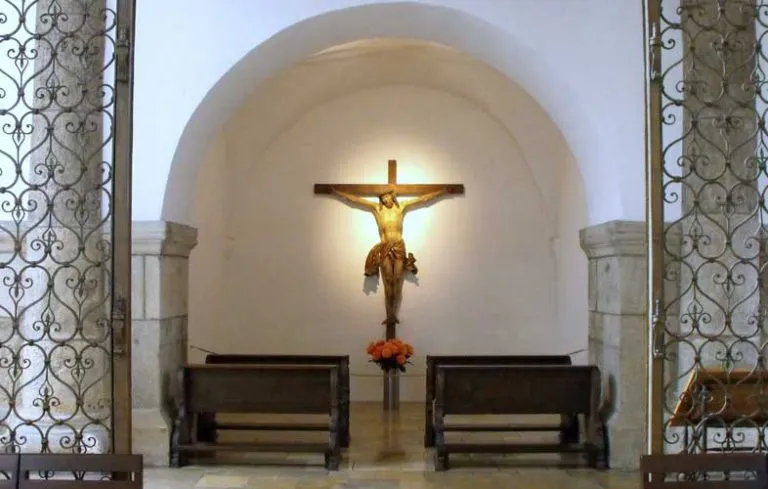
Devotion
The first chapel to be named “Mary, Untier of Knots” was completed in 1989 in Styria, Austria, inspired as a supplication in response to the Chernobyl Nuclear Tragedy. The image of “Mary, Undoer of Knots” is especially venerated in Argentina and Brazil, where churches have been named for her and devotion to her has become widespread and which the Guardian called a “religious craze”.
This devotion has become known worldwide since Cardinal Jorge Mario Bergoglio, Archbishop of Buenos Aires, was elected Pope.
It had been believed that then-Father Bergoglio had seen the painting in person while visiting Augsburg and brought a copy of the painting to Argentina; however, in an interview for the German news weekly Die Zeit in 2017, Pope Francis stated that he had never been to Augsburg. It was a German nun who sent him a Christmas greeting card with the image, which aroused his interest.
Bergoglio sent his seminarians with copies of the image to the slums of Buenos Aires, where the faithful were overwhelmed by the depiction of Mary as a knot and problem solver. He then commissioned Barbara Klimmeck, an exchange student from Eichstätt, to document the Augsburg original with all the details so that a copy could be made. In Buenos Aires, a copy was painted by the artist Ana de Betta Berti, for the Church of San José del Talar, which has had it since 8 December 1996. On the 8th of each month, thousands of people make the pilgrimage to this church.
The devotion reached Brazil near the end of the 20th century. According to Regina Novaes, of the Institute of Religious Studies in Rio de Janeiro, Mary, Untier of Knots “attracts people with small problems”. Bergoglio had this image of Mary engraved on a chalice he presented to Pope Benedict XVI and another chalice bearing her image, the work of the same silversmith, is to be presented to Pope Francis on behalf of the Argentine people.
Knowing about Pope Francis’ special devotion for this image, a new South Korean ambassador in Vatican in 2018, Baek Man Lee, presented him with a Korean painting of Our Lady Undoer of Knots. The devotion to Mary, the Untier of Knots, can be found at numerous religious sites around the world.

Marian Icon
In the Marian month of May we worship a special image of Mary in our church of St. Peter am Perlach in addition to the depiction of “Mary knot loosener”. It establishes the connection to the pilgrimage of the Bavarian dioceses to Eichstätt in 2016, which takes place as part of the preparations for the 100th anniversary of the “Patrona Bavariae” in 2017. In Eichstätt the focus is on the representation of the “Thrice Admirable Mother of God”; the picture from the Ingolstadt Cathedral of Our Lady is a copy of an old icon.
Like this city, we can also look forward to a copy (around 1700) of this miraculous image in St. Peter am Perlach. In 2015, the pilgrimage of the Bavarian dioceses led to the “Knotenmadonna” in our church, and now we are connected to the pilgrims through a common miraculous image.
Legend has it that the original icon goes back to the evangelist Luke, who paid special attention to Mary; he is also called “Marienmaler”. The oldest known depiction of the “Salus populi Romani icon” can be found in the Cappella Paolina of the Basilica Maria Maggiore in Rome. After the three stars that characterize Mary in this depiction, she is called the “Thrice Admirable” or, in extension of the Roman title, “Mary, Salvation of the Nations”.
Feast Day - 28th September
The feast of Our Lady, Untier of Knots (or undoer of knots), is celebrated on 28th September.
Mass Time
Every Days
Church Visiting Time
Contact Info
Perlach Tower, Rathausplatz,
86150 Augsburg, Bavaria, Germany.
Phone No.
Tel : +49 821 502070
Accommodations
How to reach the Church
Augsburg Airport in Affing, 7 km northeast of the city of Augsburg in Bavaria, Germany is the nearby Airport to the Church.
Augsburg, Rathausplatz Light Rail Station in Augsburg, Bavaria, Germany is the nearby Train Station to the Church.








